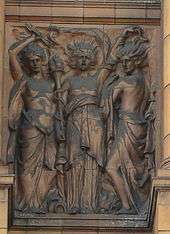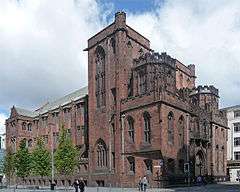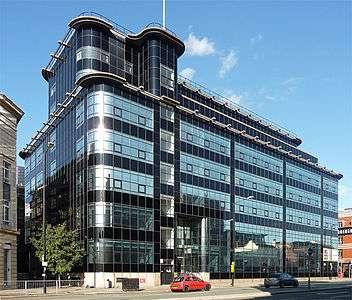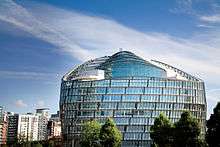London Road Fire Station, Manchester
| London Road Fire Station | |
|---|---|
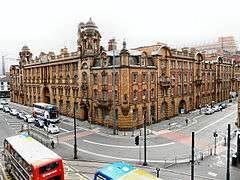 View from junction of London Road and Whitworth Street | |
| General information | |
| Type | Mixed use |
| Architectural style | Edwardian baroque architecture |
| Town or city | Manchester |
| Country | England |
| Construction started | 1904 |
| Completed | 27 September 1906 |
| Cost | £142,000 |
| Client | Manchester City Council |
| Technical details | |
| Floor count | 4 |
| Design and construction | |
| Architect | Woodhouse, Willoughby & Langham (Manchester) |
| Other designers | J J Millson, G W Parker |
| Designations | Listed Grade II* |
London Road Fire Station is a former fire station in Manchester, England. It was opened in 1906,[1] on a site bounded by London Road, Whitworth Street, Minshull Street South and Fairfield Street. Designed in the Edwardian Baroque style by Woodhouse, Willoughby and Langham in red brick and terracotta, it cost £142,000 to build. It has been a Grade II* listed building since 1974.
In addition to a fire station, the building housed a police station, an ambulance station, a bank, a coroner's court, and a gas-meter testing station. The fire station operated for eighty years, housing the firemen, their families, and the horse-drawn appliances that were replaced by motorised vehicles a few years after its opening. It was visited by royalty in 1942, in recognition of the brigade's wartime efforts. After the war it became a training centre and in 1952 became the first centre equipped to record emergency calls. However, the fire station became expensive to maintain and after council reorganisation decline set in.
The building was the headquarters of the Manchester Fire Brigade until the brigade was replaced by the Greater Manchester Fire Service in 1974. The fire station closed in 1986, since when it has been largely unused despite several redevelopment proposals. It was placed on English Heritage's Buildings at Risk Register in 2001 and in 2010 Manchester City Council served a compulsory purchase order on the fire station's owner, Britannia Hotels. Britannia announced in 2015 their intention to sell the building opening up the possibility of redevelopment after nearly 30 years of dereliction.
Construction
In 1897 the Manchester Watch Committee was considering a replacement for its fire station on Jackson's Row. A five-man sub-committee was set up and recommended a site on Newton Street. In 1899, George William Parker who had designed fire stations in Bootle and Belfast, and been referred to as the "architect of the world's fire service" was appointed Chief of the Manchester Fire Brigade and asked his opinion on the proposal. Parker reported that the site on Newton Street was unsuitable and submitted plans for a fire station on a site bounded by London Road, Whitworth Street, Minshull Street South and Fairfield Street.[2][3][4]
Parker's proposal was for a 7-bay fire station on a site more than double the size of the one proposed on Newton Street. The choice of London Road was influenced by its proximity to a development of warehouses on Whitworth Street and Princess Street. Parker convinced the city council to choose his proposals rather than those on Newton Street.[3][4][5]
A competition, with prizes of £300, £200 and £100 (equivalent to £29,000, £19,000 and £10,000 in 2016[6]) was organised to design the new fire station.[7][8] The competition drew interest from across the country, attracting 25 entries. The winning entry was by John Henry Woodhouse, George Harry Willoughby and John Langham, a team of local architects. Their design was based closely on Parker's initial plans.[7][9] The fire station was described by Fire Call magazine as "the finest fire station in this round world" before construction started.[4][8]
The fire station was built between 1904 and 1906 at a cost of £142,000 (equivalent to £13.8 million in 2016[6]).[7] The building's substructure and foundations were built by C. H. Normanton of Manchester. The superstructure was built by Gerrard's of Swinton at a cost of £75,360.[8] It was faced with red brick and terracotta by Burmantofts, a common choice for early 20th-century buildings in Manchester as it was cleanable and resisted the pollution and acid rain caused by local industry.[8] Other notable Manchester buildings from this era making use of terracotta include the Midland Hotel, the Refuge Assurance Building, the University's The Sackville Street Building (formerly known as UMIST main building) and the Victoria Baths.[9] The building's exterior featured sculptural models by John Jarvis Millson representing the functions of the building such as justice, fire and water.[1][7][10][11][12]
The building had stained glass windows and the interior was decorated with glazed bricks, similar to other public buildings of this era in the city, such as the Victoria Baths. The similarities suggest the influence and adoption of a standard design by Henry Price's newly created City Architect's Department.[13]
Operation
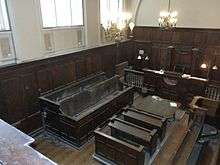
The building was opened on 27 September 1906 by the Lord Mayor of Manchester James Herbert Thewlis.[1] In addition to the fire station, it housed a police station on Whitworth Street, an ambulance station on Minshull Street South,[14] a branch of Williams Deacon's Bank at the corner of London Road and Fairfield Street,[15]<[16] a coroner's court, and a gas-meter testing station on London Road. The coroner's court and gas-meter testing station replaced the proposed public library and gym.[10][17]
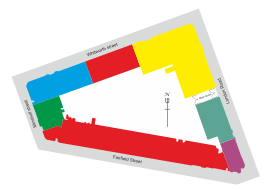
Legend
The fire station contained flats for 32 firemen and their families and 6 single firemen.[7][12] Facilities included a laundry, gym, billiards room and children's play-areas. The complex contained stables for the horses that pulled the fire appliances, and a blacksmith's workshop.[18] There were electric bells and lights to alert firemen to an alarm, poles to expedite the firemen's response, suspended harnesses to allow the horses to be harnessed quickly, and electric doors.[10] The fire station was also designed with foresight; the appliance bays were made wide enough to take motorised fire appliances.[1] The station's first motorised fire appliance arrived in 1911, five years after it opened.[19]
The building has a 130-foot (40 m) hose tower[1] and a ventilation system designed by Musgrave and Company to prevent the odour from the horses' stalls entering the firemens' living quarters. Fresh air was drawn in through the top of the fire station's tower, purified and circulated around the building. When the air reached the end of the circuit, in the stalls, it was extracted from the building. The system meant that the air in the building was replaced every 10 minutes.[17]
During the Second World War the basement was converted into an air-raid shelter and an extension built in the yard to provide more space in the control room.[20] The fire services were nationalised in 1941, and London Road became the headquarters of Division C. In recognition of the fire fighters' efforts King George VI and Queen Elizabeth visited the fire station in 1942.[13]
After the war the Manchester Fire Brigade was again municipalised, and reorganised. London Road Fire Station was restored as the headquarters of the brigade and became the only fire station serving the city centre.[21] A fire service training centre was established in 1948.[22] At about the same time, the ambulance station closed and was converted into the fire brigade's workshops.[13] The control room was modernised in 1952, becoming the first in the country with equipment to record emergency calls.[20][23]
The interior was refurbished in 1955. The exterior had been cleaned every year since the fire station opened, and as a result was in pristine condition when the building celebrated its Golden Jubilee on 6 October 1956.[24]
Decline
By the end of the 1960s maintenance was becoming increasingly expensive, and the building's design ill-suited to modern fire appliances. Plans to replace the fire station were put on hold pending the formation of the Greater Manchester Fire Service.[25]
The building has been Grade II* listed since 1974,[26] the same year that the replacement of the Manchester Fire Brigade by the Greater Manchester Fire Service precipitated the relocation of the brigade's headquarters to a new facility in Swinton. As part of the reorganisation, London Road became the headquarters of the brigade's "E Division", with the station's control room responsible for two divisions covering the City of Manchester, the Metropolitan Borough of Stockport and Tameside.[27][28]
The reorganisation meant the number of appliances was reduced, until only three remained at the station.[29] The control room at London Road closed in 1979, replaced by a single computerised control room at brigade headquarters in Swinton.[27][30]
In the same year, following the establishment of Greater Manchester Police and a reorganisation of policing in the city, the police station in the building also closed. The closure left the ground floor on the Whitworth Street side empty.[27][30] The last tenants of the bank section, a firm of solicitors, and the fire brigade's workshops, also vacated the building at about the same time.[25]
In 1984 construction work began on a £2.4 million, 4.5-acre (1.8 ha) replacement in Thompson Street and in 1985 the old London Road Fire Station was brought within the Whitworth Street Conservation Area.[31] In 1986 the fire service left London Road for its new fire station, London Road Fire Station closed and the building was sold.[2][32][33]
Dereliction and redevelopment

After the sale the building was mainly used for storage whilst planning applications to convert it into a hotel were made in 1986, 1993, and 2001, with varying degrees of success. The coroner's court was the last to vacate the premises, in 1998.[2][34][35] In 2001, the building was placed on English Heritage's Buildings at Risk Register.[36][37] By 2004 it was in steep decline, and momentum was building for the fire station's owner, Britannia Hotels, to act.[33]
In February 2006, Argent, developers proposed leasing the building from Britannia Hotels to transform it into a music and arts venue.[38][39] Manchester City Council backed the plans and refused to rule out a compulsory purchase order (CPO) if the owner did not act to redevelop the building.[40][41] Britannia Hotels branded Argent's plans "unworkable" and proposed turning the building into a company headquarters, 200-bed hotel, and fire station museum.[40] A planning application was promised by March 2006, but by May none had been made. Work was carried out by February 2007 to make the building watertight and in autumn 2007 a proposal was made by Britannia to convert the building into a hotel.[34]

Britannia Hotels appointed Purcell Miller Tritton to draw up plans to convert the building into a hotel in 2008[42] but none were produced by May 2009 and the city council lost faith in Britannia Hotels' commitment to its redevelopment.[43] The city council was concerned that the state of the fire station was limiting regeneration in the area, including a proposed government complex on the former Mayfield Railway Station site. The city council set a deadline of July 2009 for progress on redevelopment.[34][43][44] Britannia Hotels' proposal in July 2009 was to convert the fire station into a hotel with a 15-storey tower in its courtyard and promised a planning application by October 2009, but none was made and the city council's Chief Executive recommended issuing a CPO.[34][37] A meeting of the city council in January 2010 approved a request for up to £5.25 million to cover the costs associated with the fire station's acquisition.[45] Britannia Hotels responded by pledging to make a new proposal by February 2010, rendering the CPO unnecessary.[46][47]
Britannia submitted an application to turn the fire station into a 227-bed 4-star hotel in June 2010.[48] The Victorian Society praised the proposed conversion.[49][50] Manchester City Council decided to continue with the CPO.[51][52] The city council issued a CPO on 5 August 2010.[53][54] Despite the plans being approved 16 September 2010, the council continued to pursue a CPO[55][56] and solicited bids for a development partner in January 2011.[57] Britannia's objection to the CPO led to a public inquiry in April 2011.[58][59] On 29 November 2011, the Department for Communities and Local Government confirmed the CPO had been rejected.[60][61] Despite Britannia's guarantee at the inquiry to proceed with the development it reconsidered its plans. In a letter to English Heritage, Britannia said the proposed scheme was unsustainable for the foreseeable future. Britannia wanted to return to the rejected tower plan. English Heritage and the city council expressed disappointment. The city council offered to buy the building at market value.[62][63]
In February 2013 after a public meeting the Friends of London Road Fire Station (FoLRFS) was formed [64] to pressurise Britannia Hotels and persuade the council to attempt a second CPO. The group organised an online petition, fundraising events, public meetings, an online survey to discover locals' views, an art exhibition and public engagement with its history, and published the outcome of a Freedom of Information Act request on what the council had done regarding surveying the building and issuing urgent-works notices. In November 2013, Britannia applied to extend the 2010 planning permissions but despite objections the applications were approved on technical grounds in December 2013. The council considered applying for a CPO for the second time in September 2014 and confirmed its intention to do so in December 2014 and meet with FoLRFS in early 2015. FoLRFS received a grant from Locality's Community Assets in Difficult Ownership (CADO) programme to pay for public outreach work. On 30 April 2015, FoLRFS met Pat Bartoli, head of the council's urban regeneration team and Howard Bernstein who praised their campaign.[65] It was announced immediately after the meeting that Britannia Hotels had decided to sell the building.
London Road Fire Station was put on the market on 1 May 2015[66] and expected offers of around £10 million while restoration is expected to cost £20–30 million. Allied London acquired the firestation on 16 November 2015.[67]
References
Notes
- 1 2 3 4 5 Bonner 1988, p. 56
- 1 2 3 4 London Road Fire Station: Conservation Management Plan – Part 1 (PDF), Purcell Miller Tritton, 2010, retrieved 9 November 2010
- 1 2 Bonner 1986, p. 2
- 1 2 3 Bonner 1988, p. 51
- ↑ Bonner 1988, p. 54
- 1 2 UK CPI inflation numbers based on data available from Gregory Clark (2016), "The Annual RPI and Average Earnings for Britain, 1209 to Present (New Series)" MeasuringWorth.
- 1 2 3 4 5 Parkinson-Bailey2000, p. 134
- 1 2 3 4 London Road Fire Station: Conservation Management Plan – Part 3 (PDF), Purcell Miller Tritton, 2010, retrieved 9 November 2010
- 1 2 London Road Fire Station: Conservation Management Plan – Part 6 (PDF), Purcell Miller Tritton, 2010, retrieved 9 November 2010
- 1 2 3 Bonner 1986, p. 3
- 1 2 3 Wyke & Cocks 2004, pp. 92–93
- 1 2 Hartwell 2001, pp. 168–169
- 1 2 3 London Road Fire Station: Conservation Management Plan – Part 4 (PDF), Purcell Miller Tritton, 2010, retrieved 9 November 2010
- ↑ Bonner 1986, p. 6
- ↑ London Road Fire Station: Conservation Management Plan – Part 2 (PDF), Purcell Miller Tritton, 2010, retrieved 9 November 2010
- ↑ Bonner 1986, p. 27
- 1 2 Bonner 1986, p. 5
- ↑ Bonner 1986, p. 9
- ↑ Bonner 1986, p. 16
- 1 2 Bonner 1986, p. 31
- ↑ Bonner 1986, p. 26
- ↑ Bonner 1986, p. 42
- ↑ Bonner 1988, p. 92
- ↑ Bonner 1988, p. 96
- 1 2 London Road Fire Station: Conservation Management Plan – Part 5 (PDF), Purcell Miller Tritton, 2010, retrieved 9 November 2010
- ↑ Historic England, "Police and Fire Station (1197918)", National Heritage List for England, retrieved 9 October 2012
- 1 2 3 Bonner 1986, p. 44
- ↑ Bonner 1988, pp. 118–119
- ↑ Bonner 1988, p. 120
- 1 2 Bonner 1988, p. 122
- ↑ Whitworth Street Conservation Area, Manchester City Council, retrieved 10 January 2010
- ↑ Bonner 1986, p. IFC
- 1 2 Dillon, Martin (23 January 2004), "Alarm bell rings for fire station", Manchester Evening News
- 1 2 3 4 London Road Fire Station (PDF), Manchester City Council, 16 December 2009, retrieved 2 January 2010
- ↑ Manchester's London Road Fire Station — Hotel Development, Britannia Hotels, archived from the original on 5 August 2010, retrieved 5 August 2010
- ↑ Heritage At Risk Register 2010 – North West (PDF), English Heritage, 2010, p. 47, retrieved 27 October 2010
- 1 2 Council wants fire station back, BBC News, 15 December 2009, retrieved 30 December 2009
- ↑ London Road Fire Station (PDF), Manchester City Council, 26 July 2006, retrieved 3 January 2010
- ↑ London Road Fire Station (PDF), Manchester City Council, 15 February 2006, retrieved 3 January 2010
- 1 2 Burdett, Jill (11 February 2006), "All-action station", Manchester Evening News, retrieved 30 December 2009
- ↑ "Fire station's cultural future", Manchester Evening News, 17 January 2006, retrieved 30 December 2009
- ↑ Henley, Will (1 August 2008), Hotel plan for 'at risk' Manchester fire station, retrieved 3 January 2010
- 1 2 Thame, David (28 May 2009), "Burning issue at fire station", Manchester Evening News, retrieved 30 December 2009
- ↑ London Road Fire Station (PDF), Manchester City Council, 27 May 2009, retrieved 3 January 2010
- ↑ Minutes of a meeting of the Council held on 27th January 2010 (PDF), Manchester City Council, 27 January 2010, p. 4, retrieved 6 February 2010
- ↑ Linton, Deborah (26 January 2010), "£5m pledged to help save fire station", Manchester Evening News, retrieved 6 February 2010
- ↑ January 2010 Update, Britannia Hotels, archived from the original (PDF) on 5 August 2010, retrieved 6 February 2010
- ↑ Kennedy, Maev (20 July 2010), "Manchester fire station granted a reprieve", The Guardian, retrieved 31 July 2010
- ↑ Victorian Society backs Purcell Miller Tritton's Manchester hotel plan, Building, 30 July 2010, retrieved 2 August 2010
- ↑ Iconic Edwardian fire station set to become luxury hotel, The Victorian Society, 14 July 2010, retrieved 2 August 2010
- ↑ Hotel plan submitted for Manchester fire station, BBC News, 8 June 2010, retrieved 8 June 2010
- ↑ Linton, Deborah (8 June 2010), "Fire station could rise from ashes as a hotel", Manchester Evening News, retrieved 8 June 2010
- ↑ Slater, Chris (5 August 2010), "Council in move to force sale of London Road Fire Station", Manchester Evening News, retrieved 5 August 2010
- ↑ London Road Fire Station (5 August 2010), London Road Fire Station, Manchester City Council, retrieved 5 August 2010
- ↑ Planning and Highways Committee — Agenda 16 September 2010 (PDF), Manchester City Council, 16 September 2010, retrieved 18 September 2010
- ↑ London Road fire station CPO unchanged, Place North West, 17 September 2010, retrieved 18 September 2010
- ↑ Linton, Deborah; Welsh, Pamela (6 January 2011), "Developers preparing bids for London Road fire station hotel plan", Manchester Evening News, retrieved 29 November 2011
- ↑ Donohue, Simon (10 February 2011), "20 years on, inquiry will finally decide London Road fire station fate", Manchester Evening News, retrieved 29 November 2011
- ↑ Williams, Jennifer (13 April 2011), We had to buy London Road fire station to save it, Manchester council tells public inquiry, retrieved 29 November 2011
- ↑ Linton, Deborah (29 November 2011), Manchester council loses £700,000 bid to force sale of London Road Fire Station, retrieved 29 November 2011
- ↑ Eric Pickles rejects CPO for empty Manchester building, BBC News, 29 November 2011, retrieved 3 December 2011
- ↑ Schofield, Jonathan (6 March 2012), English Heritage Slams Britannia Hotels, Manchester Confidential, retrieved 26 June 2012
- ↑ Report for Resolution – London Road Fire Station (PDF), Manchester City Council, 14 March 2012, retrieved 26 June 2012
- ↑ http://www.manchesterconfidential.co.uk/News/Public-Meeting-London-Road-Fire-Station-27-February
- ↑ http://www.theguardian.com/commentisfree/2015/may/01/london-road-fire-station-activists-citizen-heritage-manchester
- ↑ The sale brochure
- ↑ Blake, David. "Allied London Acquire London Road Fire Station". manchesterconfidential.co.uk. Retrieved 2016-02-20.
Bibliography
- Bonner, Robert (1986), The finest fire station in this round world: a history of London Road Fire Station, Manchester, Manchester: GMC Public Relations Unit
- Bonner, Robert (1988), Manchester Fire Brigade, Manchester: Archive Publications, ISBN 0-948946-29-6
- Hartwell, Clare (2001), Manchester, Pevsner Architectural Guides, Harmondsworth: Penguin Books, ISBN 978-0-14-071131-8
- Parkinson-Bailey, John (2000), Manchester: an architectural history, Manchester: Manchester University Press, ISBN 978-0-7190-5606-2
- Wyke, Terry; Cocks, Harry (2004), Public sculpture of Greater Manchester, Liverpool: Liverpool University Press, ISBN 978-0-85323-567-5
External links
| Wikimedia Commons has media related to London Road Fire Station. |
Coordinates: 53°28′36″N 2°13′56″W / 53.47667°N 2.23222°W
